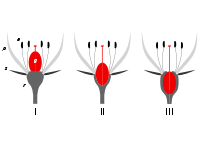Gynoeceum


With Gynoeceum even gynaeceum or Gynäzeum (both Latinized forms of ancient Greek γυναικεῖον gynaikeion "women's quarters") refers to the totality of Megasporophylle ( carpels , carpels - colloquially: "female" flower organs) of flowers from seed plants . Carpels carry the ovules in which the embryo sac cell ( megaspore ) and the female gametophyte develop from it; after fertilization of the egg cell of the gametophyte, the seed forms (see also: seed plants, generation change ).
The components of the gynoeceum are involved in the formation of the fruit in the Bedecktsamern . The shape and composition of the gynoeceum are important features in assessing the systematic position of plant taxa. The morphology of the gynoeceum plays a crucial role in the pollination and distribution of the seeds and can thus provide information about aspects of the ecology of a plant.
The carpels of the Bedecktsamern are arranged spirally or whorled on the flower axis. The fruit leaves the Bedecktsamer divided into a lower, fertile area with the ovules, the ovary (ovary) and an upper sterile portion, the pen (stylus), the upper end for receiving the pollen grains serving scar represents (stigma). The term stamp (pestle) is often used here .
Carpels are congenitally fused from below in the form of a tube (congenital: the fusing is already in place when the tissue is formed). Part of the area above grows together post-genitally; the seam of the postgenital adhesions (suture) is visible on the carpels of many taxa. On both sides of the border, the ovules form inside the carpel; the tissue from which the ovules emerge is called the placenta . Vascular bundles run on the dorsal side of the carpel opposite the suture and in the placenta .
The section of the flower axis with the carpels is in different positions to the androeceum or the perianth , in some taxa axis tissue forms an internode and thus lifts the other flower organs and / or the gynoeceum (see under ovary ). It is believed that the original Gynoceae were composed of a multitude of free-standing carpels. In the course of evolution , forms with few or only one carpel have developed ( oligomerization ), as well as gynoecea with carpels that have grown together. Gynoeces with free carpels are called chorikarp or apocarp, Gynocees with overgrown carpels are called coenocarp.
Apocarps Gynoeceen, morphology of the carpels
Apokarpe or chorikarpe , multicarpellate Gynoeceen consist of several and not among fused carpels. An apo-, chorikarpes gynoeceum form z. B. the buttercups . A unikarpes , unicarpellates gynoeceum, with only a single carpel is also possible .
Several partially overgrown ovaries can also be present at the same time. It is possible that the adjacent carpels are only partially, just overgrown with free styles (hemi-apocarpous, semicarpous) or are connected by the flower base (pseudo-coenocarp). It is rare that two or more ovaries from different flowers can be wholly or partially fused to form a syngynium (pseudo-monomeric).
Coenocarps Gynoeceen
In coenocarpic and syn- or paracarpic gynoeces, the carpels are fused with one another with free or fused styles. If carpels have grown together over their entire length, the number of scar lobes can give an indication of the number of carpels involved in the formation of the gynoeceum.
In cross-section, the ovaries of coeno-synkarper gynoecea show a number of compartments, chambers (loculi, loculaments), which correspond to the interiors of the fused carpels. The compartments are separated by real partitions ( septa ), which are formed by the side surfaces of the carpels. A coeno-synkarpes gynoeceum have z. B. the lily plants .
In coeno-paracarpic ovaries, no or only poorly developed partitions are formed; they usually have an uncharged interior.
In some plants there are invaginations or septa in the ovary that do not go back to the side surfaces of overgrown carpels, but rather arise through growth, overgrowth from the surface of the carpels or placental tissue ("false partitions"), e.g. B. in some cruciferous plants .
If the real partition walls of the carpel margins in the center of the ovary are free from one another, it is incompletely septate ( hemi- synkarp , -parakarp ). In an ovary there can be more or less fanned and / or unfanned areas in sections or there can be different placentations as in the case of the pomegranate . A continuous column (columella) can also form in the middle of the ovary. The carpels are often synkarp in the basal area, but paracarp farther distal, which is why a distinction is no longer made between coeno-parakarp and -synkarp, but only all coenocarp ovaries are generally referred to as synkarp.
Position of the placenta
Nectaries
With a gynoeceum septal nectaries , septum nectaries ; Sunken nectaries can be formed on the contact surfaces of neighboring carpels (carpels) with an outward duct. Nectaries can also be present on the outside of the ovary. Scar secretions can also take on a nectar function. Nectaries can also occur on a stylus cushion.
swell
- P. Sitte , H. Ziegler , F. Ehrendorfer , A. Bresinsky : Textbook of botany at universities. Founded by E. Strasburger. 33rd edition, Fischer, Stuttgart 1991, ISBN 3-437-20447-5 .
- W. Troll : Practical introduction to plant morphology. A help book for botanical lessons and self-study. Second part: The blooming plant , VEB Gustav Fischer, Jena 1957, (Reprint 1975, ISBN 3-87429-085-9 ).
- Birgit Gemeinholzer: Systematics of plants compact. Springer, 2018, ISBN 978-3-662-55233-9 , p. 158 f.
- E. Strasburger , P. Sitte, H. Ziegler: Textbook of botany for universities. 34th edition, Fischer, 1998, ISBN 3-437-25500-2 , p. 727.
- Morphology and systematics of native vascular plants (various PDF files → Gynoeceum), from STiNE - Universität Hamburg, accessed on May 22, 2019.
Individual evidence
- ↑ Thomas Stützel: Botanical determination exercises. 3rd edition, Ulmer, 2015, ISBN 978-3-8252-8549-4 , p. 38 f.

